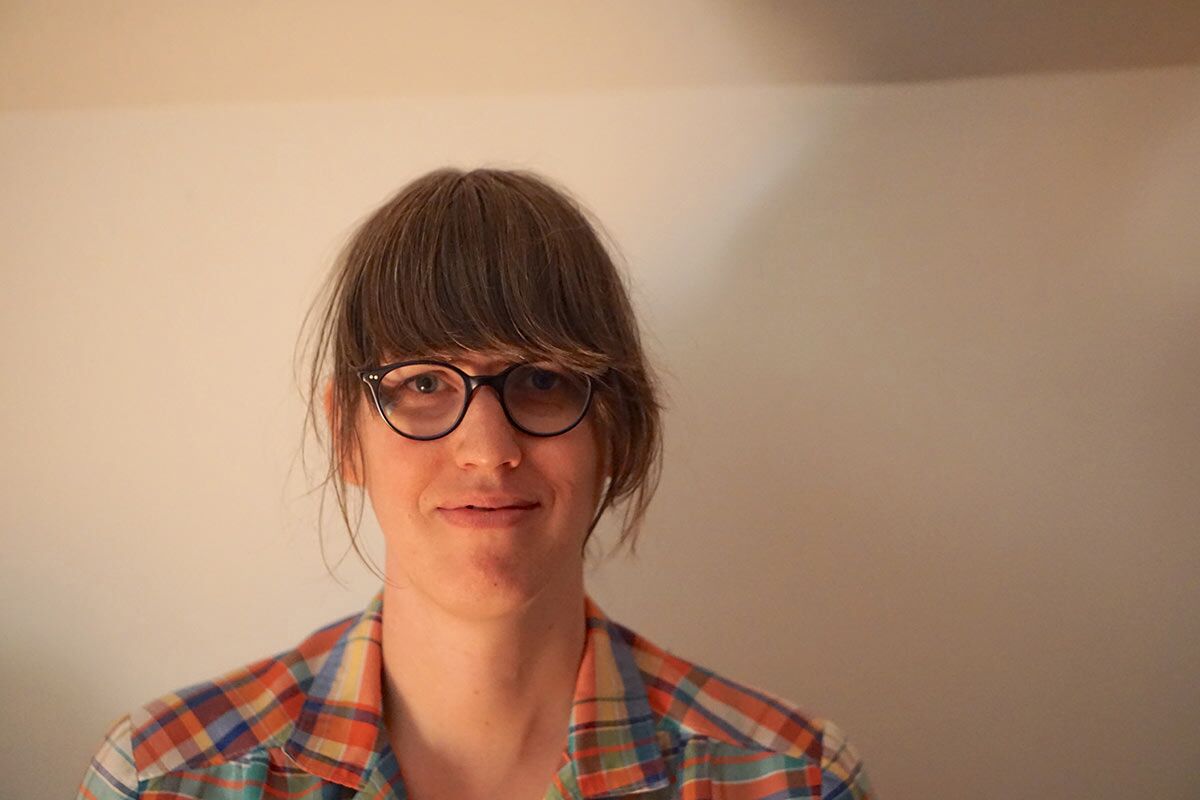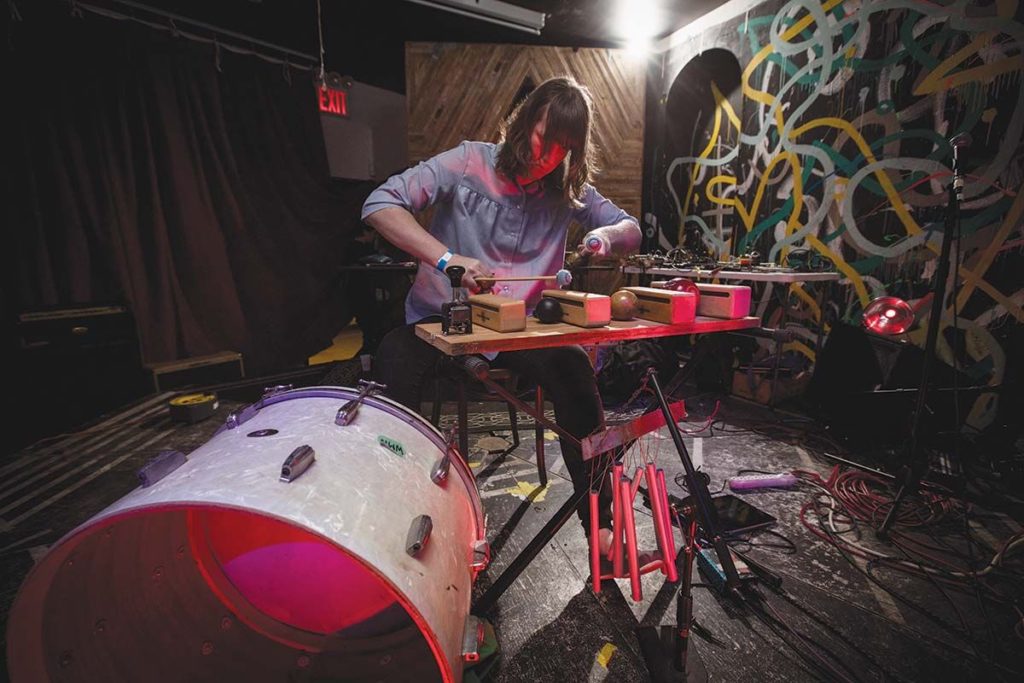Header photo by Walter-Wlodarczyk
By Chloe Saavedra
Sarah Hennies is a minimalist composer who focuses on transforming simple instruments into ambiguous composing tools when they interact with a physical space. The New York–based, trans female and queer composer and percussionist has been playing music for as long as she can remember. She grew up in the indie-punk scene in Louisville, Kentucky, and started gravitating toward weird music at age 15. She is also classically trained, having attended a performing arts high school, and she eventually got her master’s from University of California, San Diego.
Hennies has her own label, Weighter Recordings, and is a member of improvisational group Meridian, and of the Queer Percussion Research Group. In November 2017, at New York’s Issue Project Room, with a cast of transgender women, she premiered Contralto—a large scale installation with strings and percussion. We took a virtual journey through Skype to speak about the connections between accepting the complexity of gender identity and the perceptions that come with playing live.
Tom Tom: Your music is so much about physical space and how the room interacts with where you are positioned as a listener and all the intangible variables that cannot be contained in a digital recording. How do you reconcile turning that presence into an online entity?
Sarah Hennies: I’ve steered my recordings away from a “you have to be there” acoustic phenomenon, because it was so problematic to record something and capture the full effect of the music. I just want to reach more people than I can from only playing shows. Documenting your work is really important, but it’s no substitute for hearing live music.
Tom Tom: So many musicians now have the opposite feeling. They wonder how to translate their electronic music to real life.
Sarah Hennies: Recordings are always a different experience from live music. In some cases, the recording can be better, depending on what you’re trying to do. If you play a roll on a cymbal with soft mallets in a live performance, the audience sees that that is a cymbal. They see an object they recognize and have existing assumptions about. With a recording, you have the ability to remove those associations.
Tom Tom: It can be more imaginative that way.
Sarah Hennies: For example, when you put a mic very close to a cymbal, you can hear a really low fundamental that you can’t hear without the use of a microphone. The sound is totally transformed through the recording or amplification process.

Tom Tom: My class saw your woodblock piece at the Bard College performance. Do you have an extent to how you apply manipulations to your recordings?
Sarah Hennies: Morton Feldman famously said, “I don’t push the sounds around,” which is how I approach making decisions while making a piece. I try to let the sounds dictate how I will use them. The act of making a field recording is already corrupting the experience of what you’re recording, because it automatically implies there is a person there recording this, and they are making a decision about what you are going to hear. [In an essay I wrote], I’m writing about my waterfall piece. I talk about the decision to insert vibraphone sounds into the field recording of a waterfall, because I felt that I was using the vibraphone to say “I am here.”
The decision to use vibraphone was this acknowledgement that I am present in this recording, and without it, listeners might get the false impression that the waterfall recording is pristine and untouched by a human, that it’s just rushing water. But that’s never true, because I’ve had to make all these choices about how I’m recording the waterfall—where the microphone is placed, how long I will record it, what time of day, what the weather is like, and so on.
[The] solo woodblock piece, [it] is a more direct presentation of challenging your assumptions about something versus what you actually hear or experience. The piece proves your expectation wrong about what a woodblock is and sounds like. There’s no right or wrong way to react to sound, but I’m trying to make an experience with sound that is ambiguous in terms of what it is giving you.
Tom Tom: What do you think about the “doing” of listening and the assumptions a listener brings to the table while watching someone live? An audience member sees a woman playing this percussion instrument and has ideas about what that will sound like based on their preconceived notions as well as what they’re actually hearing/seeing. The listener cannot escape the “doing” of listening unless the instrument player’s identity as well as the instruments cannot be seen, like in a recording. When you hear a female voice, you can’t get out of that box. But at the same time, we do certain things to combat this, which in effect makes it even more about gender. It’s a problematic cycle. Do you think about this conundrum?
Sarah Hennies: Yeah, the way that I arrived at the things I’m doing now was by asking the question about sounds, “What is this really?” Because, yeah, it’s cool, a woodblock does this thing that you don’t think it’s gonna do, but why is this compelling to me? I came to the conclusion that the reason I was making this music for so long was because it was completely upending the identity of this instrument; it’s like what you said that if people hear a woman, or someone they perceive to be a woman, they immediately have all of these ideas, whether they’re aware of them or not.
When most people see a person they cannot identify as male or female, it just “breaks” them. Julia Serano has written a lot about why trans women are disproportionately discriminated against and how people constantly categorize each other as either male or female. She goes on in depth about how damaging that is if you’re someone who does not fall into either category in a neat way. That to me is the real-life gender version of this kind of music: This thing that you’re making all of these assumptions about is actually way more complicated than what you’re willing to accept.
You shouldn’t assume that simple things are simple. Not that I think of what I’m doing as trying to teach people lessons at all, but I feel like using art to create situations that are analogous to real life issues is what art is for. I was making this music and then realized it was reflective of who I was after the fact. It’s just a tool to learn basically.
Tom Tom: My class was shocked by the overtones and weird unexpected sounds we were hearing around the space at the woodblock performance. If you would have prefaced that piece with what you just said about gender and identity, we would have thought very differently about it. So many people talk about gender identity politics with their art and music, and sometimes it seems like it precedes the creation, which can detract from the depth of content.
Sarah Hennies: I think that’s true. I think part of it is kind of coy on my end, like, “I’m not gonna give you any hints about this, because, I didn’t have any help.” I had to do this myself and learn these things that were extremely complicated and difficult. It feels more representative of the experience that generates the response, “What the fuck is going on?”—which to me is a great place to be. I almost don’t even care what the music sounds like. I can like almost everything, if it puts me in a place of not understanding what’s happening.
This article was featured in the Sex issue of Tom Tom. Purchase it online.
Psstttt, have you visited our web store? Check it out here for all your Tom Tom merch needs!


